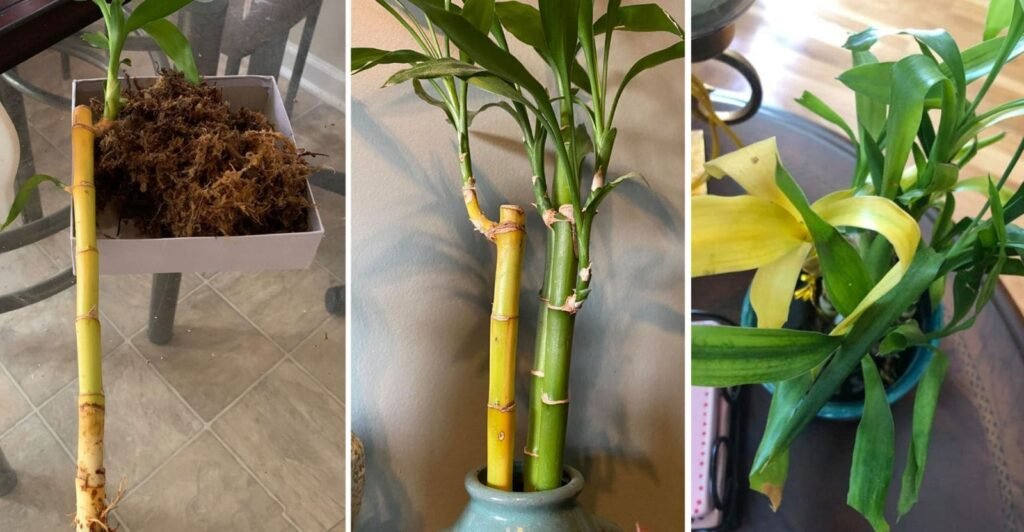
Why Is My Lucky Bamboo Turning Yellow?
If you’ve noticed your lucky bamboo turning yellow, you’re not alone. Lucky bamboo (Dracaena sanderiana) is a popular indoor plant known for its air-purifying qualities and its ability to thrive in various environments. However, when it starts turning yellow, it’s a sign that something is off.
The yellowing could be happening on either the top or bottom part of the plant, and each situation has different causes. The good news is that most of these issues can be corrected with a bit of attention and care.
Let’s dive into the reasons why your lucky bamboo might be turning yellow and how to fix it.
Common Reasons for Yellowing Lucky Bamboo

Lucky bamboo can turn yellow for several reasons, and it’s important to identify the cause to restore its health. Here’s a breakdown of some of the most common culprits:
1. Sunlight Issues
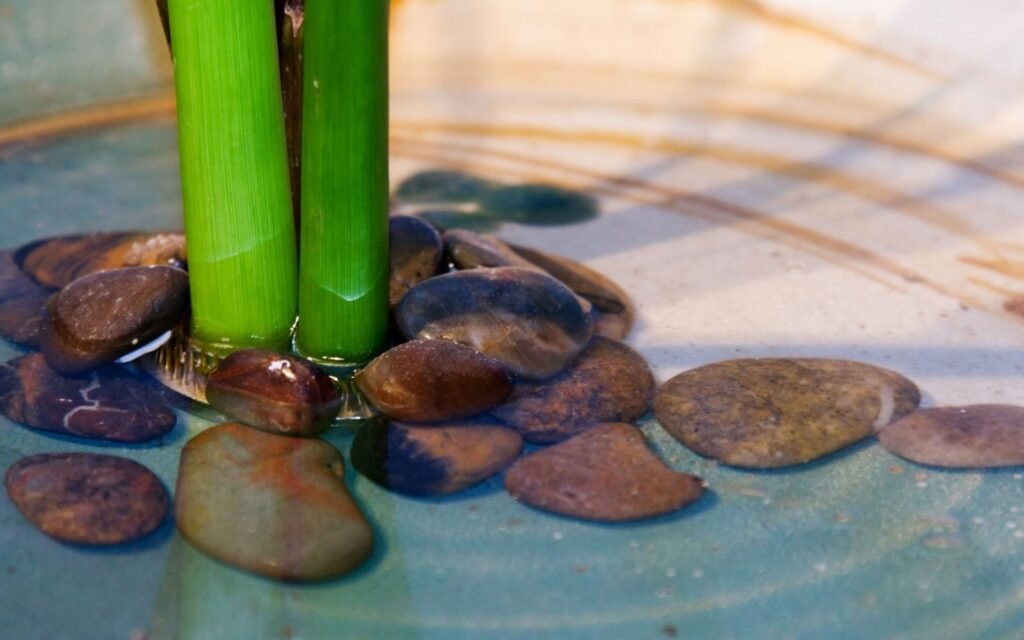
Lucky bamboo needs indirect, filtered light to thrive. If it’s exposed to direct sunlight, its leaves can scorch and turn yellow. On the other hand, if it’s not getting enough light, it may also turn yellow due to poor photosynthesis.
To fix this, move your bamboo to a place with indirect sunlight (like near a window with curtains). If natural light is limited, you can place the plant near artificial light or use a grow light. Keep the temperature between 65°F and 85°F (18°C–29°C) for optimal growth.
2. Watering Issues

Lucky bamboo is sensitive to the water it’s grown in, especially if it’s planted in water instead of soil. Chlorinated or fluoride-rich tap water can cause stress to the plant, leading to yellowing leaves.
To avoid this, use distilled, filtered, or bottled water. If you must use tap water, let it sit for 24 hours to let the chlorine evaporate before using it. It’s also a good idea to change the water in your vase every 7–10 days to keep it fresh and free from bacteria and algae.
If your bamboo is planted in soil, make sure the top layer of soil is dry before watering again. Lucky bamboo likes moisture, but it shouldn’t be sitting in soggy soil.
3. Iron and Nutrient Deficiency

Lucky bamboo can sometimes turn yellow due to a lack of nutrients, particularly iron, which is essential for healthy chlorophyll production. If you notice yellowing between the veins of the leaves, it could be a sign of iron deficiency.
To address this, you can use a balanced liquid fertilizer. Fertilize your lucky bamboo once or twice a year, as too much fertilizer can cause yellowing as well. If the yellowing starts at the bottom of the stem and moves up, it might be a sign of over-fertilizing.
4. Insect Infestation
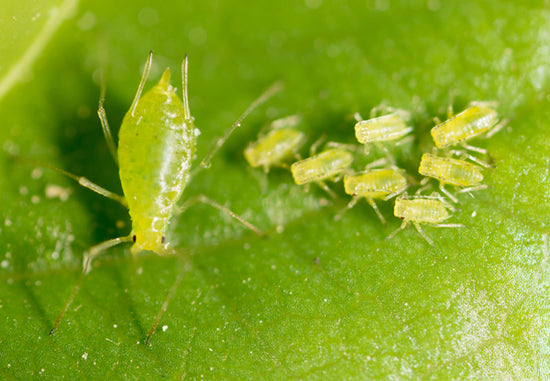
Lucky bamboo is prone to insect infestations, including spider mites, mealybugs, and scale. These pests suck the juices from the plant’s stems and leaves, which can lead to yellowing, curling, and leaf drop.
If you see small bugs on the plant or a web-like substance, it’s time to take action. To get rid of the pests, gently wipe the leaves with a soft cloth and treat the plant with insecticidal soap. You can also regularly mist the plant to raise humidity, as these pests prefer dry conditions.
5. Injury or Damage
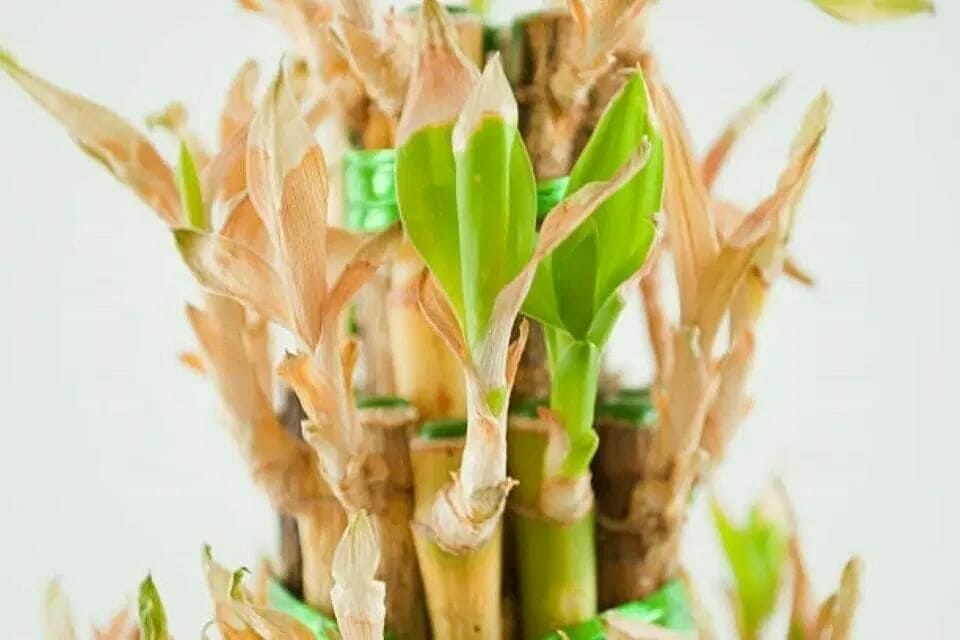
Physical damage to the plant—whether from handling, an accident, or some environmental factor—can also cause yellowing. If the stems or leaves are damaged, they might start to turn yellow and eventually die.
Gently trim off any yellowing, damaged leaves or stems to allow the plant to focus its energy on the healthy parts.
Can You Revive Yellowing Lucky Bamboo?
:max_bytes(150000):strip_icc()/GettyImages-1387503641-333b99da29bf487598deed97c2fc4af2.jpg)
If your lucky bamboo has turned yellow, you might be wondering if you can bring it back to life. The good news is that it is possible to save it, especially if only the leaves are yellow and the stems are still green.
If only the leaves are yellowing:
- Remove the yellow leaves to give the plant a cleaner look.
- Change the water or check the soil for proper moisture levels.
- Move the plant to a better-lit location (but avoid direct sunlight).
- Be patient—it might take some time, but new growth should come in green.
If part of the stem has turned yellow:
- You can cut off the yellowed part of the stem, leaving the healthy green part.
- Propagate the healthy stem in fresh water or soil and it should grow new roots in a few weeks.
If your plant has suffered from an insect infestation, treating the plant with insecticidal soap or a mild dish soap solution will help rid it of pests.
How to Save Your Yellowing Bamboo

Here are some steps to help you revive your lucky bamboo:
- Trim off any yellow or dead parts of the plant.
- Change the water to fresh, non-chlorinated water.
- Move the plant to a better location with indirect light.
- Check for pests and treat the plant accordingly.
- Give it a little extra care by trimming any unwanted, damaged leaves and keeping the plant clean.
Fertilizing Your Lucky Bamboo

When your lucky bamboo starts to yellow, be cautious with fertilization. It’s easy to overdo it, which can make the problem worse. Use a diluted liquid fertilizer and apply it once or twice a year. Avoid fertilizing when the plant is already stressed or yellowing.
Trimming Lucky Bamboo

Trimming your lucky bamboo can help keep it healthy and looking neat. Since this plant grows quickly, you may find that it becomes top-heavy or too tall. Trimming can encourage new growth and keep it looking fresh. Be sure to use a sharp, clean pair of pruners to avoid damaging the plant. Always sterilize your pruning tools with rubbing alcohol or disinfectant wipes to prevent transferring any diseases.
Can Lucky Bamboo Grow in Water?
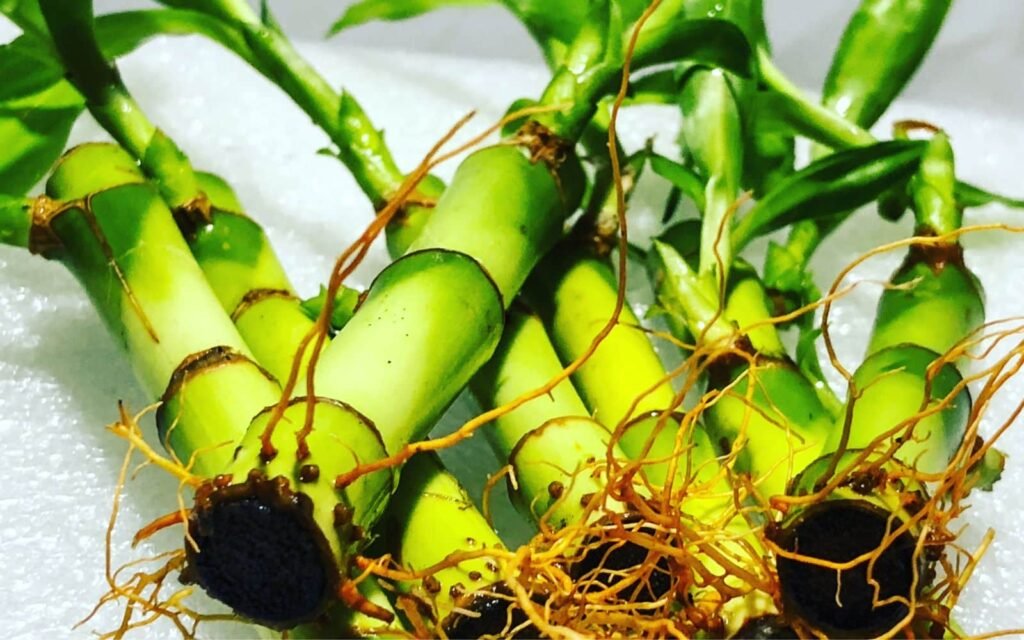
Yes, lucky bamboo can grow in water without the need for soil, which makes it a popular choice for indoor decoration. However, if you choose to grow it in water, be sure to follow the care instructions carefully—particularly with respect to water changes and keeping the water fresh.
FAQs for Growing and Caring for Lucky Bamboo
1. What are the ideal growing conditions for lucky bamboo?
Lucky bamboo thrives in bright, indirect light but can tolerate low light conditions. It prefers warm temperatures between 65°F and 90°F (18°C – 32°C). It can grow in water or soil, but it’s essential to provide well-draining conditions, whether it’s in a pot with soil or a water container.
2. How often should I water lucky bamboo?
Lucky bamboo should be watered regularly, but the amount and frequency depend on whether it’s growing in water or soil.
- In water: Change the water every 7-10 days to prevent stagnation and algae growth. Make sure the roots are submerged, and only use filtered or distilled water, as tap water with chlorine or fluoride can harm the plant.
- In soil: Water when the top inch of soil feels dry. Ensure the pot has drainage holes to avoid waterlogging.
3. What type of water is best for lucky bamboo?
Lucky bamboo prefers filtered or distilled water. Tap water, especially if it contains chlorine or fluoride, can lead to yellowing leaves and stunted growth. If using tap water, let it sit for 24 hours to allow chlorine to dissipate before using it to water your plant.
4. Why are the leaves on my lucky bamboo turning yellow?
Yellowing leaves on lucky bamboo can indicate several things:
- Water quality: Chlorine or fluoride in tap water can cause yellowing. Switch to distilled or filtered water.
- Overwatering or underwatering: If the soil is waterlogged or too dry, the leaves may yellow. Adjust your watering schedule based on the plant’s environment.
- Excessive sunlight: Too much direct sunlight can scorch the leaves, leading to yellowing. Ensure the plant is in a location with bright, indirect light.
5. How can I encourage lucky bamboo to grow straight?
Lucky bamboo will naturally bend toward the light, so to encourage straight growth, rotate the plant every few days so that all sides receive equal light exposure. This will prevent it from leaning toward one direction.
6. Can I keep lucky bamboo in a decorative container without soil?
Yes, lucky bamboo can be grown in a container with water instead of soil. Make sure the roots are submerged in clean water and that the container provides adequate drainage. It’s essential to change the water regularly (every 7-10 days) to keep it healthy.
7. How do I fertilize lucky bamboo?
Lucky bamboo does not require frequent fertilizing. If growing in water, use a diluted, liquid fertilizer designed for houseplants once every 1-2 months during the growing season (spring and summer). If grown in soil, you can use a balanced, water-soluble fertilizer every 6-8 weeks.
8. How do I prune my lucky bamboo?
To maintain the shape and size of your lucky bamboo, prune back any yellow or damaged leaves. You can also trim the top of the stalk to encourage branching. Use clean, sharp scissors or pruning shears, and avoid cutting into the healthy part of the stalk to prevent stress to the plant.
9. Can lucky bamboo grow in low light?
Yes, lucky bamboo can tolerate low light but will grow more slowly in such conditions. It thrives best in bright, indirect light. If grown in low light for extended periods, the plant may become leggy and weak. Providing a little more light can help promote better growth.
10. Why is my lucky bamboo turning brown at the tips?
Brown tips can be caused by a variety of factors:
- Water quality: Tap water with high chlorine or fluoride can cause brown tips. Use filtered or distilled water.
- Dry air: Lucky bamboo prefers moderate humidity. If the air in your home is too dry, misting the leaves or placing the plant near a humidifier can help.
- Overfertilizing: Excessive fertilizer can lead to a buildup of salts, which causes brown tips. Be sure to dilute the fertilizer properly and use it sparingly.
11. How long does lucky bamboo live?
With proper care, lucky bamboo can live for many years. Depending on the environment and care, it can live anywhere from 5-10 years, and sometimes even longer. Regular attention to water quality, light, and occasional pruning can help extend the lifespan of your plant.
12. Can lucky bamboo grow in soil instead of water?
Yes, lucky bamboo can be grown in soil. Use a well-draining potting mix, and ensure the soil is kept slightly moist (but not waterlogged). Lucky bamboo grown in soil may require a bit more regular watering compared to when it’s in water, as the soil can dry out faster.
Conclusion
Lucky bamboo is a beautiful, low-maintenance plant that can easily thrive with the right care. If you notice yellowing, it’s usually a sign that something needs attention. By adjusting water quality, sunlight, and nutrients, you can bring your lucky bamboo back to life. With just a bit of care and attention, your lucky bamboo will stay lush and vibrant in your home for years to come!

